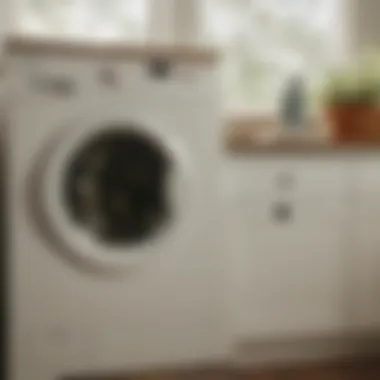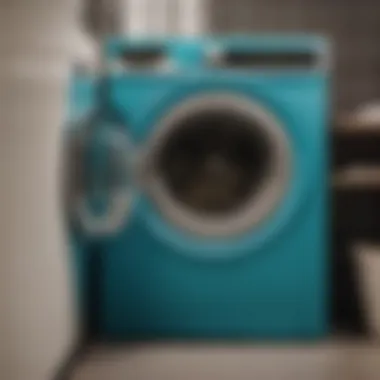Ultimate Guide: How to Clean Your Laundry Machine with Vinegar


Materials:
- Distilled white vinegar (2 cups)
- Baking soda (1/4 cup)
- Microfiber cloth
- Water
DIY Steps:
- Turn off the machine and unplug it for safety
- Mix the vinegar with water in a spray bottle
- Wipe down the machine with the vinegar solution and a microfiber cloth
- Run a wash cycle with hot water and vinegar to clean the inside
- Sprinkle baking soda inside the drum and run another hot wash cycle
- Wipe down the exterior of the machine with a fresh vinegar solution
Technical Aspects:
-- Tools: Spray bottle, microfiber cloth -- Timing: Plan for about 30 minutes to complete the cleaning process -- Techniques: Ensure thorough wiping and running of hot cycles for maximum effectiveness
DIY Project Process:
-- Start by turning off and unplugging the machine -- Mix vinegar and water, spray and wipe the inside and outside of the machine -- Run hot water and vinegar cycles followed by a baking soda cycle -- Troubleshooting Tips: If the machine still smells, consider repeating the process or checking for hidden areas needing cleaning
Understanding the Importance of Cleaning Your Laundry Machine
Maintaining a clean laundry machine holds immense importance in keeping your household running smoothly. Neglecting this crucial task can lead to a myriad of issues that compromise your machine's efficiency and lifespan. The significance of maintaining a clean laundry machine cannot be overstated, as it directly impacts the quality of your laundry results and the overall functionality of your appliance.
One key aspect of maintaining a clean laundry machine is ensuring that dirt and grime do not accumulate within its various components. The presence of dirt and grime can hinder the machine's performance, leading to subpar cleaning results and potential breakdowns. By regularly cleaning your machine, you can prevent the build-up of these unwanted substances, thus optimizing its efficiency and prolonging its lifespan.
The impact of dirt and grime on machine efficiency is profound. Not only do they impede the proper functioning of the machine, but they can also harbor bacteria and mold, compromising the cleanliness of your laundry. Additionally, dirt and grime can cause components to wear out more quickly, necessitating costly repairs or even replacements. By understanding the significance of maintaining a clean laundry machine, you are taking proactive steps to ensure that your appliance operates at peak performance for years to come.


Understanding Vinegar Cleaning
In this article, the section on Understanding Vinegar Cleaning plays a crucial role in providing readers with in-depth knowledge of how vinegar can be leveraged effectively to clean laundry machines. Vinegar stands out as a versatile and eco-friendly cleaning agent, garnering attention for its potent antibacterial and antifungal properties. Understanding the dynamics of vinegar cleaning is essential for those aiming to adopt a more natural and sustainable approach to household cleaning routines.
When delving into the realm of vinegar cleaning, it is imperative to explore the various types of vinegar available for cleaning purposes, each offering unique cleaning properties and benefits. From white vinegar to apple cider vinegar, the array of options can be overwhelming. Selecting the most suitable vinegar for your laundry machine entails a thoughtful consideration of its cleaning attributes and compatibility with different machine materials and components.
Moving beyond mere household cleaners, vinegar embodies a distinct mechanism in cleaning that sets it apart from conventional products. Its chemical reaction with dirt and buildup is not only effective but also gentle on surfaces, making it a preferred choice for those seeking a non-toxic cleaning alternative. The ability of vinegar to break down deposits thoroughly ensures a deep and comprehensive cleaning of your laundry machine, promoting longevity and optimal performance.
Safety precautions must not be overlooked when using vinegar for cleaning. Protective measures to avoid skin and eye irritation are paramount, underscoring the importance of safeguarding oneself during the cleaning process. Adequate ventilation during cleaning is also crucial to mitigate any potential risks associated with inhaling vinegar fumes, ensuring a safe and healthy cleaning environment for both you and your machine.
Step-by-Step Cleaning Guide
Cleaning your laundry machine using vinegar is a critical task to ensure its optimal performance and longevity. This detailed guide will walk you through each step of the process, highlighting the essential elements, benefits, and considerations to guarantee a sparkling clean machine every time.
Preparing Your Laundry Machine
To start the cleaning process effectively, the initial step involves unplugging the machine and emptying its contents. This crucial task ensures safety and allows for thorough inspection and cleaning. By taking the time to unplug the machine, you prevent the risk of electrical accidents and create a safe working environment for the cleaning process. Additionally, emptying the machine removes any leftover items that could interfere with the cleaning procedure, setting the stage for a successful maintenance session.
Inspecting for any Visible Debris
Inspecting the machine for any visible debris is a key aspect of pre-cleaning preparations. By examining the interior of the machine, you can identify any dirt, lint, or other buildups that may affect its performance. This step enables you to pinpoint potential areas of concern and address them proactively. Removing visible debris before beginning the cleaning cycle ensures that the vinegar can penetrate deeply and clean the machine effectively, promoting optimal functionality.
Cleaning the Detergent Dispenser and Filters
Once the machine is unplugged and emptied, the next step involves cleaning the detergent dispenser and filters. Removing these components and soaking them in a vinegar solution is a crucial process for eliminating built-up residue and blockages. By scrubbing away residue from the dispenser and filters, you enhance the overall performance of the machine and prevent potential clogs that could impede its operation.


Scrubbing Away Residue for Optimal Performance
Scrubbing away residue from the detergent dispenser and filters is essential for achieving optimal performance. This step ensures that no traces of buildup remain, guaranteeing that the machine operates efficiently. By thoroughly cleansing these components, you maintain the integrity of the machine and prolong its lifespan, ultimately saving you from costly repairs or replacements in the future.
Running a Cleaning Cycle with Vinegar
Running a cleaning cycle with vinegar is a key aspect of maintaining your laundry machine. Setting the machine for a hot water cycle and adding vinegar allows the cleaning solution to penetrate the internal components, breaking down dirt and grime effectively. Allowing the cycle to complete ensures that every part of the machine undergoes thorough cleaning, resulting in a fresh and sanitized appliance ready for use.
Setting the Machine for a Hot Water Cycle
The first step in running a cleaning cycle involves setting the machine for a hot water cycle. Heating water to high temperatures enhances the cleaning power of vinegar, facilitating the removal of stubborn residues and bacteria. This process sanitizes the machine's interior and ensures a hygienic environment for your laundry.
Adding Vinegar and Allowing the Cycle to Complete
Adding vinegar to the hot water cycle is a crucial step in effectively cleaning your laundry machine. Vinegar's natural properties break down mineral deposits and grime, leaving your machine fresh and odor-free. By allowing the cycle to complete, you give vinegar ample time to work its magic and restore your machine to optimal cleanliness.
Wiping Down Exterior Surfaces
Cleaning the exterior surfaces of your laundry machine is just as important as maintaining its internal components. Using vinegar to clean buttons, knobs, and the door seal is a safe and effective way to remove dirt and germs. By wiping down these areas with vinegar, you eliminate bacteria buildup and create a hygienic environment for operating the machine.
Drying Thoroughly to Prevent Mold Growth
After cleaning the exterior surfaces, it's essential to dry them thoroughly to prevent mold growth. Moisture left behind can lead to mold formation, compromising the cleanliness of your machine. By ensuring that all surfaces are completely dry, you reduce the risk of mold growth and maintain a sanitized laundry environment.
Machine Maintenance Tips


Machine maintenance is a crucial aspect of ensuring the longevity and efficiency of your laundry machine. By following a regular maintenance schedule and incorporating vinegar cleaning into your routine, you can keep your machine running smoothly for years to come. Consistent maintenance also helps in identifying and addressing common issues such as mold or mildew growth and detergent buildup, ensuring optimal performance.
Regular Cleaning Schedule
Frequency recommendations for optimal machine performance
When it comes to maintaining your laundry machine, establishing a frequency of cleaning is key. For optimal machine performance, it is recommended to clean the machine with vinegar every 1-3 months, depending on usage. This regular schedule helps prevent mold and mildew growth, detergent buildup, and ensures that the machine functions at its best. Incorporating regular cleaning into your routine is a small investment of time that pays off in the long run by extending the life of your machine.
Incorporating vinegar cleaning into your routine
Incorporating vinegar cleaning into your routine is a simple yet effective way to ensure your machine stays clean and odor-free. By regularly using vinegar to clean your machine, you harness its natural antibacterial and antifungal properties to eliminate germs and residue. This eco-friendly alternative to harsh chemicals not only helps in maintaining a clean machine but also reduces the risk of respiratory issues associated with chemical cleaners. Adding vinegar cleaning to your routine is a healthy choice for both your family and the environment.
Troubleshooting Common Issues
Identifying and addressing mold or mildew growth
Identifying and addressing mold or mildew growth is imperative to prevent further damage to your laundry machine and maintain a hygienic laundry environment. Common signs of mold or mildew include musty odors and visible dark spots. By promptly addressing these issues with vinegar cleaning, you can effectively remove mold and mildew, preventing them from spreading and causing potential health hazards. Regular maintenance and vigilance help in early detection and swift resolution of mold or mildew growth.
Resolving detergent buildup
Resolving detergent buildup is a common issue that can impact the performance of your laundry machine. Over time, detergent residue can accumulate in various parts of the machine, leading to inefficiencies and malfunctions. By using vinegar to dissolve and remove this buildup, you can enhance the machine's effectiveness and prevent clogs. Regular cleaning sessions focused on detergent buildup ensure that your machine operates smoothly and efficiently.
Professional Maintenance Considerations
Scheduling professional servicing for deep cleaning
While regular home maintenance is essential, scheduling professional servicing for deep cleaning is recommended to address more complex issues and ensure thorough upkeep. Professional technicians have the expertise and specialized tools to disassemble and clean intricate parts of the machine that are not easily accessible during routine cleaning. By opting for professional servicing periodically, you can enhance the overall performance and longevity of your laundry machine.
Consulting experts for machine health evaluation
Consulting experts for machine health evaluation provides valuable insights into the condition of your laundry machine beyond visible indicators. Industry professionals can conduct diagnostics to assess the machine's functionality, detect potential issues early on, and recommend specific maintenance or repairs. By seeking expert advice, you can make informed decisions about the care and maintenance of your machine, optimizing its performance and longevity.







